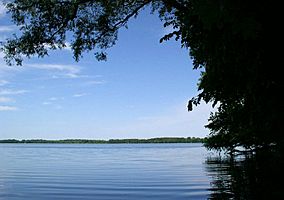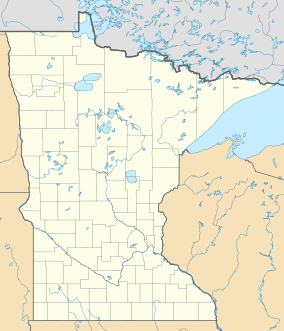Myre-Big Island State Park facts for kids
Quick facts for kids Myre-Big Island State Park |
|
|---|---|

Albert Lea Lake from Myre-Big Island State Park
|
|
| Location | Freeborn, Minnesota, United States |
| Area | 1,578 acres (6.39 km2) |
| Elevation | 1,230 ft (370 m) |
| Established | 1947 |
| Governing body | Minnesota Department of Natural Resources |
Myre-Big Island State Park is a fun place to visit in Minnesota, USA. It's located right outside the city of Albert Lea. This park covers about 1,578 acres (6.39 km²) and protects 8 miles (13 km) of the shoreline of Albert Lea Lake.
The main part of the park is called Big Island. It's a 117-acre (0.47 km²) island connected to the mainland by a special road called a causeway. Another causeway connects Big Island to a smaller area called Little Island. The park used to be called Helmer Myre State Park, named after a former Minnesota State Senator named Helmer Myre.
Contents
Natural Wonders of the Park
This park sits on a special landform called the Bemis Moraine. A moraine is like a big pile of rocks and dirt left behind by a glacier. This particular moraine shows where a huge ice sheet stopped about 10,000 years ago during the Ice Age.
As the glacier melted and moved back, the moraine blocked the water. This created Albert Lea Lake, which covers about 2,600 acres (11 km²). The park also has an esker. An esker is a winding ridge of sand and gravel. It forms from streams that flow under a melting glacier.
Plants and Habitats
The mainland part of the park is mostly covered in oak savanna. This is a type of grassland with scattered oak trees. There are also several wet areas called wetlands. Park rangers are working to keep these areas healthy. They do things like controlled burning (controlled fires) and manage water levels.
Big Island is different because it was protected from wildfires. This allowed a thick forest to grow, which looks like an old forest. This forest has many kinds of trees, including maple, basswood, elm, green ash, ironwood, and red oak. Along the lake, you'll find willow trees.
Albert Lea Lake has a lot of nutrients, which means it's eutrophic. Lakes like this naturally fill in over time. However, this process has sped up because of water running off farms, which adds extra nutrients.
Amazing Wildlife
Myre-Big Island State Park is home to many animals. You might spot white-tailed deer, red and gray foxes, raccoons, muskrats, opossums, squirrels, and different kinds of bats.
Birdwatching Opportunities
The park is also a great place for birdwatching. Many birds stop here during their spring and fall migrations. One special bird you might see is the American white pelican. These large birds gather in big groups on Albert Lea Lake.
Park History and Development
People have lived around the lakes in this area for about 9,000 years. We know this because of old tools and items found here. A local person named Owen Johnson collected many of these artifacts in the 1940s.
Owen Johnson and State Senator Helmer Myre both wanted to protect Big Island as a state park. At the time, Big Island was owned by many different people, and some were planning to cut down the trees. In 1947, a law supported by Senator Myre was passed. This law allowed the Department of Conservation to buy the 117-acre (0.47 km²) island. Local supporters also raised money to help buy the land and create picnic areas and trails.
The park was called Big Island State Park for a while, but it didn't get an official name until 1953. It was then named Myre State Park to honor Senator Myre, who had passed away two years earlier.
Growing the Park
In the early 1960s, a campground was added to Big Island. But the island was quite small for many visitors. When it was announced that two major highways, Interstate 90 and Interstate 35, would meet near Albert Lea, local groups pushed for more land to be added to the park. In 1963, an additional 839 acres (3.40 km²) on the mainland were approved for the park.
Later, in 1974, a company bought 560 acres (2.27 km²) northeast of the park to build on. This land included part of the lake shore and the esker. Again, strong local support helped add this land to the park, even with legal and money challenges.
In 1972, Owen Johnson donated his collection of Native American artifacts to the park. These items are kept at the Owen Johnson Interpretive Center. They are used for research but are not currently on public display. In 1990, the park's names were combined to create its current official name: Myre-Big Island State Park.
Fun Things to Do
Myre-Big Island State Park offers many activities for visitors!
- Boating:
- You can launch your boat from Little Island.
- Canoes are available to rent.
- You can also take boat tours of Albert Lea Lake that start from town.
- Camping:
- The Big Island Campground has 34 wooded sites, and 17 of them have electricity. There's also 1 camper cabin.
- White Fox Campground has 59 open sites, with 15 offering electricity.
- Little Island Pioneer Group Camp can hold up to 50 people and is for tent camping only.
- New York Point Group Camp allows tent or vehicle camping and has access to a kitchen, dining hall, showers, and restrooms.
- There are also 4 special sites for backpacking.
- Fishing:
- You can fish in Albert Lea Lake for fish like black bullhead, carp, northern pike, and various panfish.
- Trails:
- The park has 16 miles (26 km) of hiking trails.
- There are 7 miles (11 km) of mountain biking trails.
- In winter, you can enjoy 8 miles (13 km) of cross-country skiing trails.
- There are also 7 miles (11 km) of snowmobiling trails.
- The Blazing Star State Trail is a paved trail that's 6.5 miles (10.5 km) long. It starts in Albert Lea and goes near the esker. This trail is planned to extend even further, about 20 miles (32 km), to Austin, Minnesota.
- Swimming:
- The lake is too shallow and has too many plants for swimming.




